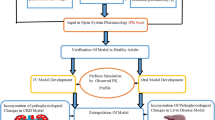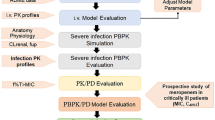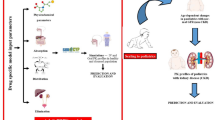Abstract
Aim:
To develop and evaluate a whole-body physiologically based pharmacokinetic (WB-PBPK) model of bisoprolol and to simulate its exposure and disposition in healthy adults and patients with renal function impairment.
Methods:
Bisoprolol dispositions in 14 tissue compartments were described by perfusion-limited compartments. Based the tissue composition equations and drug-specific properties such as log P, permeability, and plasma protein binding published in literatures, the absorption and whole-body distribution of bisoprolol was predicted using the 'Advanced Compartmental Absorption Transit' (ACAT) model and the whole-body disposition model, respectively. Renal and hepatic clearances were simulated using empirical scaling methods followed by incorporation into the WB-PBPK model. Model refinements were conducted after a comparison of the simulated concentration-time profiles and pharmacokinetic parameters with the observed data in healthy adults following intravenous and oral administration. Finally, the WB-PBPK model coupled with a Monte Carlo simulation was employed to predict the mean and variability of bisoprolol pharmacokinetics in virtual healthy subjects and patients.
Results:
The simulated and observed data after both intravenous and oral dosing showed good agreement for all of the dose levels in the reported normal adult population groups. The predicted pharmacokinetic parameters (AUC, Cmax, and Tmax) were reasonably consistent (<1.3-fold error) with the observed values after single oral administration of doses ranging from of 5 to 20 mg using the refined WB-PBPK model. The simulated plasma profiles after multiple oral administration of bisoprolol in healthy adults and patient with renal impairment matched well with the observed profiles.
Conclusion:
The WB-PBPK model successfully predicts the intravenous and oral pharmacokinetics of bisoprolol across multiple dose levels in diverse normal adult human populations and patients with renal insufficiency.
Similar content being viewed by others

Log in or create a free account to read this content
Gain free access to this article, as well as selected content from this journal and more on nature.com
or
References
Cruickshank JM . Beta-blockers and heart failure. Indian Heart J 2010; 62: 101–10.
de Groote P, Ennezat PV, Mouquet F . Bisoprolol in the treatment of chronic heart failure. Vasc Health Risk Manag 2007; 3: 431–9.
McGavin JK, Keating GM . Bisoprolol: a review of its use in chronic heart failure. Drugs 2002; 62: 2677–96.
Papadopulos DP, Papademetriou V . Low-dose fixed combination of bisoprolol /hydrochlorothiazide as first line for hypertension: a review of the rationale and clinical evidence. Angiology 2009; 60: 601–7.
CIBIS-II Investigators and Committees. The cardiac insufficiency bisoprolol study II (CIBIS-II): a randomised trial. Lancet 1999; 353: 9–13.
Hillege HL, Nitsch D, Pfeffer MA, Swedberg K, McMurray JJ, Yusuf S, et al. Renal function as a predictor of outcome in a broad spectrum of patients with heart failure. Circulation 2006; 113: 671–8.
Damman K, Voors AA, Hillege HL, Navis G, Lechat P, van Veldhuisen DJ, et al. Congestion in chronic systolic heart failure is related to renal dysfunction and increased mortality. Eur J Heart Fail 2010; 12: 974–82.
López-Sendón J, Swedberg K, McMurray J, Tamargo J, Maggioni AP, Dargie H, et al. Expert consensus document on beta-adrenergic receptor blockers. Eur Heart J 2004; 25: 1341–62.
Brophy KM, Scarlett-Ferguson H, Webber KS . Clinical drug therapy for Canadian practice. 2nd ed. Philadelphia: Lippincott Williams & Wilkins; 2010.
Kirch W, Rose I, Demers HG, Leopold G, Pabst J, Ohnhaus EE . Pharmacokinetics of bisoprolol during repeated oral administration to healthy volunteers and patients with kidney or liver disease. Clin Pharmacokinet 1987; 13: 110–7.
Nestorov I . Whole body pharmacokinetic models. Clin Pharmacokinet 2003; 42: 883–908.
Rowland M, Balant L, Peck C . Physiologically based pharmacokinetics in drug development and regulatory science: a workshop report (Georgetown University, Washington, DC, May 29–30, 2002). AAPS PharmSci 2004; 6: E6.
Edginton AN, Theil FP, Schmitt W, Willmann S . Whole body physiologically-based pharmacokinetic models: their use in clinical drug development. Expert Opin Drug Metab Toxicol 2008; 4: 1143–52.
Rowland M, Peck C, Tucker G . Physiologically-based pharmacokinetics in drug development and regulatory science. Annu Rev Pharmacol Toxicol 2011; 51: 45–73.
Le Jeunne C, Poirier JM, Cheymol G, Ertzbischoff O, Engel F, Hugues FC . Pharmacokinetics of intravenous bisoprolol in obese and non-obese volunteers. Eur J Clin Pharmacol 1991; 41: 171–4.
Leopold G, Pabst J, Ungethüm W, Bühring KU . Basic pharmacokinetics of bisoprolol, a new highly beta 1-selective adrenoceptor antagonist. J Clin Pharmacol 1986; 26: 616–21.
Ding L, Zhou X, Guo X, Song Q, He J, Xu G . LC-ESI-MS method for the determination of bisoprolol in human plasma. J Pharm Biomed Anal 2007; 44: 520–5.
Jones HM, Gardner IB, Watson KJ . Modelling and PBPK simulation in drug discovery. AAPS J 2009; 11: 155–66.
Jones HM, Dickins M, Youdim K, Gosset JR, Attkins NJ, Hay TL, et al. Application of PBPK modelling in drug discovery and development at Pfizer. Xenobiotica 2012; 42: 94–106.
Simulations Plus, Inc. GastroPlus 7.0 manual. California: The Inc; 2010.
Jones HM, Parrott N, Jorga K, Lavé T . A novel strategy for physiologically based predictions of human pharmacokinetics. Clin Pharmacokinet 2006; 45: 511–42.
Poirier A, Funk C, Scherrmann JM, Lavé T . Mechanistic modeling of hepatic transport from cells to whole body: application to napsagatran and fexofenadine. Mol Pharm 2009; 6: 1716–33.
Rodgers T, Leahy D, Rowland M . Physiologically based pharmacokinetic modeling 1: predicting the tissue distribution of moderate-to-strong bases. J Pharm Sci 2005; 94: 1259–76.
Rodgers T, Rowland M . Physiologically based pharmacokinetic modelling 2: predicting the tissue distribution of acids, very weak bases, neutrals and zwitterions. J Pharm Sci 2006; 95: 1238–57.
Parrott N, Davies B, Hoffmann G, Koerner A, Lave T, Prinssen E, et al. Development of a physiologically based model for oseltamivir and simulation of pharmacokinetics in neonates and infants. Clin Pharmacokinet 2011; 50: 613–23.
Hinderling PH . Red blood cells: a neglected compartment in pharmacokinetics and pharmacodynamics. Pharmacol Rev 1997; 49: 279–95.
Yang J, Jamei M, Yeo KR, Rostami-Hodjegan A, Tucker GT . Misuse of the well-stirred model of hepatic drug clearance. Drug Metab Dispos 2007; 35: 501–2.
Gabrielsson J, Weiner D . Pharmacokinetic and pharmacodynamic data analysis: concept and applications, 4th ed. Stockholm: Swedish Pharmaceutical Press; 2006.
Lin JH . Species similarities and differences in pharmacokinetics. Drug Metab Dispos 1995; 22: 1008–21.
Lin JH . Applications and limitations of interspecies scaling and in vitro extrapolation in pharmacokinetics. Drug Metab Dispos 1998; 26: 1202–12.
Agoram B, Woltosz WS, Bolger MB . Predicting the impact of physiological and biochemical processes on oral drug bioavailability. Adv Drug Deliv Rev 2001; 50: S41–67.
Huang W, Lee SL, Yu LX . Mechanistic approaches to predicting oral drug absorption. AAPS J 2009; 11: 217–24.
Li GF, Yang J, Zhang XY, Zhao HR . Physiologically based gastrointestinal models for the prediction of oral drug absorption. Chin J Clin Pharmacol Ther 2010; 15: 656–62. Chinese.
Kuentz M, Nick S, Parrott N, Röthlisberger D . A strategy for preclinical formulation development using GastroPlus as pharmacokinetic simulation tool and a statistical screening design applied to a dog study. Eur J Pharm Sci 2006; 27: 91–9.
Parrott N, Paquereau N, Coassolo P, Lave T . An evaluation of the utility of physiologically based models of pharmacokinetics in early drug discovery. J Pharm Sci 2005; 94: 2327–43.
Reddy MB, Connor A, Brennan BJ, Morcos PN, Zhou A, McLawhon P, et al. Physiological modeling and assessments of regional drug bioavailability of danoprevir to determine whether a controlled release formulation is feasible. Biopharm Drug Dispos 2011; 32: 261–75.
Davies B, Morris T . Physiological parameters in laboratory animals and humans. Pharm Res 1993; 10: 1093–5.
Dressman JB, Amidon GL, Reppas C, Shah VP . Dissolution testing as a prognostic tool for oral drug absorption: immediate release dosage forms. Pharm Res 1998; 15: 11–22.
Zhang X, Lionberger RA, Davit BM, Yu LX . Utility of physiologically based absorption modeling in implementing quality by design in drug development. AAPS J 2011; 13: 59–71.
National Center for Health Statistics (NCHS), Centers for Disease Control and Prevention (CDC). National Health and Nutrition Examination Survey data. Hyattsville, MD: CDC, 2010.
Ogiu N, Nakamura Y, Ijiri I, Hiraiwa K, Ogiu T . A statistical analysis of the internal organ weights of normal Japanese people. Health Phys 1997; 72: 368–83.
Mannhold R, Poda GI, Ostermann C, Tetko IV . Calculation of molecular lipophilicity: State-of-the-art and comparison of log P methods on more than 96 000 compounds. J Pharm Sci 2008; 98: 861–93.
De Buck SS, Sinha VK, Fenu LA, Gilissen RA, Mackie CE, et al. The prediction of drug metabolism, tissue distribution, and bioavailability of 50 structurally diverse compounds in rat using mechanism-based absorption, distribution, and metabolism prediction tools. Drug Metab Dispos 2007; 35: 649–59.
Lee AC, Crippen GM . Predicting pKa. J Chem Inf Model 2009; 49: 2013–33.
Rodgers T, Leahy D, Rowland M . Tissue distribution of basic drugs: accounting for enantiomeric, compound and regional differences amongst beta-blocking drugs in rat. J Pharm Sci 2005; 94: 1237–48.
Gomeni R . PHARM — an interactive graphic program for individual and population pharmacokinetic parameter estimation. Comput Biol Med 1984; 14: 25–34.
Abuasal BS, Bolger MB, Walker DK, Kaddoumi A . In silico modeling for the nonlinear absorption kinetics of UK-343,664: a P-gp and CYP3A4 substrate. Mol Pharm 2012; 9: 492–504.
Tubic M, Wagner D, Spahn-Langguth H, Bolger MB, Langguth P . In silico modeling of nonlinear drug absorption for the P-gp substrate talinolol and of consequences for the resulting pharmacodynamic effect. Pharm Res 2006; 23: 1712–20.
Peters SA . Identification of intestinal loss of a drug through physiologically based pharmacokinetic simulation of plasma concentration-time profiles. Clin Pharmacokinet 2008; 47: 245–59.
Peters SA, Hultin L . Early identification of drug-induced impairment of gastric emptying through physiologically based pharmacokinetic (PBPK) simulation of plasma concentration-time profiles in rat. J Pharmacokinet Pharmacodyn 2008; 35: 1–30.
Parrott N, Lave T . Applications of physiologically based absorption models in drug discovery and development. Mol Pharm 2008; 5: 760–75.
Fruehauf H, Goetze O, Steingoetter A, Kwiatek M, Boesiger P, Thumshirn M, et al. Intersubject and intrasubject variability of gastric volumes in response to isocaloric liquid meals in functional dyspepsia and health. Neurogastroenterol Motil 2007; 19: 553–61.
Brophy CM, Moore JG, Christian PE, Egger MJ, Taylor AT . Variability of gastric emptying measurements in man employing standardized radiolabeled meals. Dig Dis Sci 1986; 31: 799–806.
Petring OU, Flachs H . Inter- and intrasubject variability of gastric emptying in healthy volunteers measured by scintigraphy and paracetamol absorption. Br J Clin Pharmacol 1990; 29: 703–8.
Poulin P, Theil FP . Prediction of pharmacokinetics prior to in vivo studies. 1. Mechanism-based prediction of volume of distribution. J Pharma Sci 2002; 91: 129–56.
De Buck SS, Sinha VK, Fenu LA, Nijsen MJ, Mackie CE, Gilissen RA . Prediction of human pharmacokinetics using physiologically based modeling: a retrospective analysis of 26 clinically tested drugs. Drug Metab Dispos 2007; 35: 1766–80.
Yamazaki S, Skaptason J, Romero D, Vekich S, Jones HM, Tan W, et al. Prediction of oral pharmacokinetics of cMet kinase inhibitors in humans: physiologically based pharmacokinetic model versus traditional one compartment model. Drug Metab Dispos 2011; 39: 383–93.
Yang X, Gandhi YA, Duignan DB, Morris ME . Prediction of biliary excretion in rats and humans using molecular weight and quantitative structure-pharmacokinetic relationships. AAPS J 2009; 11: 511–25.
Willmann S, Höhn K, Edginton A, Sevestre M, Solodenko J, Weiss W, et al. Development of a physiology-based whole-body population model for assessing the influence of individual variability on the pharmacokinetics of drugs. J Pharmacokinet Pharmacodyn 2007; 34: 401–31.
Howell BA, Chauhan A . A physiologically based pharmacokinetic (PBPK) model for predicting the efficacy of drug overdose treatment with liposomes in man. J Pharm Sci 2010; 99: 3601–19.
Lave T, Parrott N, Grimm HP, Fleury A, Reddy M . Challenges and opportunities with modelling and simulation in drug discovery and drug development. Xenobiotica 2007; 37: 1295–310.
Tahara K, Kagawa Y, Takaai M, Taguchi M, Hashimoto Y . Directional transcellular transport of bisoprolol in P-glycoprotein-expressed LLC-GA5-COL150 cells, but not in renal epithelial LLC-PK1 cells. Drug Metab Pharmacokinet 2008; 23: 340–6.
Thomas S . Clinical relevance of predictive physiologically based pharmacokinetic methods. Expert Opin Drug Dis 2008; 3: 725–32.
Huang SM, Temple R, Xiao S, Zhang L, Lesko LJ . When to conduct a renal impairment study during drug development: US Food and Drug Administration perspective. Clin Pharmacol Ther 2009; 86: 475–9.
Nestorov I . Modelling and simulation of variability and uncertainty in toxicokinetics and pharmacokinetics. Toxicol Lett 2001; 120: 411–20.
Thompson CM, Johns DO, Sonawane B, Barton HA, Hattis D, Tardif R, et al. Database for physiologically based pharmacokinetic (PBPK) modeling: physiological data for healthy and health-impaired elderly. J Toxicol Environ Health B Crit Rev 2009; 12: 1–24.
Hudachek SF, Gustafson DL . Customized in silico population mimics actual population in docetaxel population pharmacokinetic analysis. J Pharm Sci 2011; 100: 1156–66.
Acknowledgements
This work is supported by the Program for Shanghai Innovative Research Team in University (2009), the E-institutes of the Shanghai Municipal Education Commission (E03008) and the National Science and Technology Supporting Projects of China (2008BAI51B03).
Author information
Authors and Affiliations
Corresponding authors
Rights and permissions
About this article
Cite this article
Li, Gf., Wang, K., Chen, R. et al. Simulation of the pharmacokinetics of bisoprolol in healthy adults and patients with impaired renal function using whole-body physiologically based pharmacokinetic modeling. Acta Pharmacol Sin 33, 1359–1371 (2012). https://doi.org/10.1038/aps.2012.103
Received:
Accepted:
Published:
Issue date:
DOI: https://doi.org/10.1038/aps.2012.103
Keywords
This article is cited by
-
Application of a physiologically based pharmacokinetic model in predicting captopril disposition in children with chronic kidney disease
Scientific Reports (2023)
-
A Comprehensive Whole-Body Physiologically Based Pharmacokinetic Drug–Drug–Gene Interaction Model of Metformin and Cimetidine in Healthy Adults and Renally Impaired Individuals
Clinical Pharmacokinetics (2020)
-
Towards a Generic Tool for Prediction of Meropenem Systemic and Infection-Site Exposure: A Physiologically Based Pharmacokinetic Model for Adult Patients with Pneumonia
Drugs in R&D (2019)
-
Interethnic scaling of fraction unbound of a drug in plasma and volume of distribution: an analysis of extrapolation from Caucasians to Chinese
European Journal of Clinical Pharmacology (2019)
-
Impact of Ethnicity-Specific Hepatic Microsomal Scaling Factor, Liver Weight, and Cytochrome P450 (CYP) 1A2 Content on Physiologically Based Prediction of CYP1A2-Mediated Pharmacokinetics in Young and Elderly Chinese Adults
Clinical Pharmacokinetics (2019)


